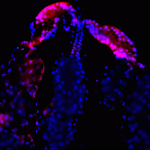Link to Pubmed [PMID] – 30833735
Link to DOI – 10.1038/s41564-019-0376-y
Nat Microbiol 2019 05; 4(5): 854-863
The global population at risk from mosquito-borne diseases-including dengue, yellow fever, chikungunya and Zika-is expanding in concert with changes in the distribution of two key vectors: Aedes aegypti and Aedes albopictus. The distribution of these species is largely driven by both human movement and the presence of suitable climate. Using statistical mapping techniques, we show that human movement patterns explain the spread of both species in Europe and the United States following their introduction. We find that the spread of Ae. aegypti is characterized by long distance importations, while Ae. albopictus has expanded more along the fringes of its distribution. We describe these processes and predict the future distributions of both species in response to accelerating urbanization, connectivity and climate change. Global surveillance and control efforts that aim to mitigate the spread of chikungunya, dengue, yellow fever and Zika viruses must consider the so far unabated spread of these mosquitos. Our maps and predictions offer an opportunity to strategically target surveillance and control programmes and thereby augment efforts to reduce arbovirus burden in human populations globally.


